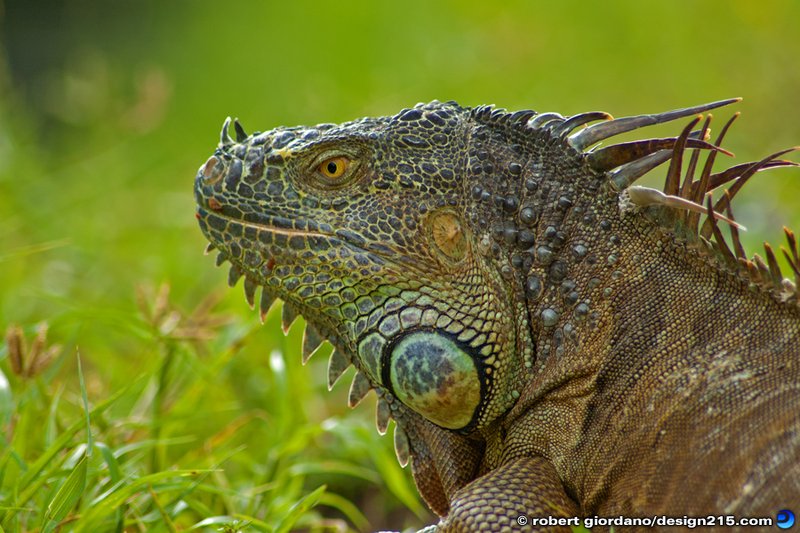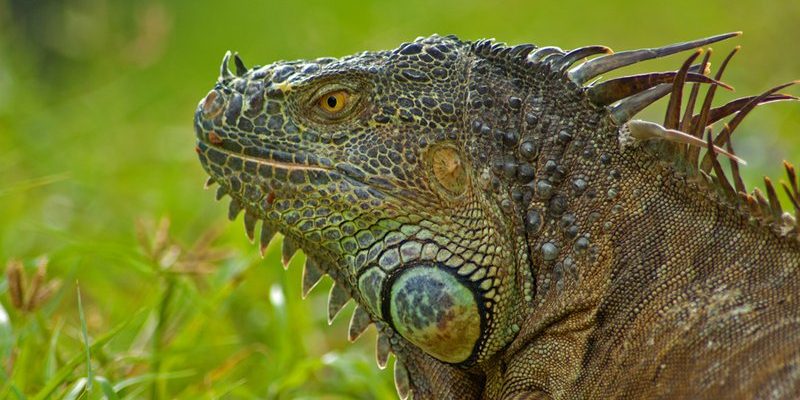
The Common Iguana is not just any reptile; it’s a stunning creature that captures the imagination. With their vibrant colors and unique features, these lizards are often the stars of the terrarium and an icon of the tropical landscape. But there’s much more to them than just their looks. From their eating habits to their social behaviors, the Common Iguana reveals interesting insights about nature and adaptation.
You might be wondering why these reptiles have become so popular among pet owners and conservationists alike. It’s not just their appearance; it’s their fascinating lifestyle and social structure that makes them particularly captivating. Despite being native to Central and South America, their presence can be felt all over the world. So, let’s delve into the life of the Common Iguana, and uncover what makes this species so special.
Physical Characteristics of the Common Iguana
The Common Iguana is a large lizard, capable of reaching sizes of up to 6 feet in length, including its long tail. They typically weigh around 11 to 20 pounds, making them one of the larger iguana species. Their vibrant green color, which can also take on shades of brown and gray, serves as a perfect camouflage among the leaves in their natural habitat. As they age, some iguanas even exhibit a more subdued color palette.
One of the most striking features of the Common Iguana is its long, spiky crest that runs down its back. These spines aren’t just for show; they help in regulating body temperature and can also play a role in communication. If you ever see an iguana puffing up its body or changing color slightly, it’s often expressing stress or excitement, a behavior vital for their survival in the wild.
Another fascinating aspect is their powerful jaws and teeth, adapted for their herbivorous diet. Iguanas have sharp, flat teeth capable of crushing tough leaves and fruits. This ability plays a significant role in their daily feeding routines, allowing them to consume a variety of vegetation, which brings us to their dietary habits.
Diet and Feeding Habits
Common Iguanas are classified as herbivores, primarily feeding on leaves, flowers, fruits, and some vegetables. In fact, up to 95% of their diet can consist of leafy greens, which provide essential nutrients. These reptiles have specialized teeth that can easily tear through fibrous plant material, allowing them to thrive in their natural habitat, where food sources can be abundant yet varied.
You might find it surprising that iguanas can also consume certain types of flowers and fruits, adding sweetness to their meals. Hibiscus and dandelions are among their favorites. However, they must be careful about what they eat. Some plants can be toxic, so it’s crucial for them to rely on instinct and experience when foraging and to avoid potentially harmful foliage.
In captivity, owners should mimic this diet by providing fresh greens and occasional fruits to keep their pets healthy. Proper nutrition is vital not just for growth but also for maintaining vibrant colors and a healthy digestive system. A well-balanced diet will significantly contribute to the iguana’s overall well-being throughout its life.
Habitat and Range
Common Iguanas are typically found in tropical rainforests, savannas, and coastal areas throughout Central and South America, including the Caribbean islands. They thrive in humid environments, often basking in the sun on tree branches or rocks to regulate their body temperature. In urban environments, these lizards have adapted well, often seen lounging in gardens and parks.
Interestingly, they are excellent climbers. Their sharp claws help them navigate through trees and shrubs, making it easier to escape predators or find food. Their natural habitat is crucial for their survival, as it provides not only food but also security against threats. Unfortunately, habitat destruction poses a significant risk to their populations, making conservation efforts increasingly important.
As these iguanas face challenges from habitat loss, their adaptability shines through. Some populations have even started to thrive in urban settings, showing just how resilient they can be. However, preserving their natural habitats remains a priority for ensuring their future.
Social Behavior and Reproduction
The social dynamics of Common Iguanas can be quite intriguing. These lizards are generally solitary creatures, but during the mating season, they exhibit fascinating behaviors. Males often engage in territorial displays, puffing up their bodies, bobbing their heads, and making deep vocalizations to attract females and ward off rivals. It’s a bit like a dance, showcasing both strength and flexibility.
During mating season, which typically occurs in the spring, females will seek out the most suitable males, often after observing their displays from a distance. Once paired, the female will lay around 20 to 70 eggs in a burrow, which she carefully conceals. This instinctual behavior is crucial for protecting her offspring from predators, as the hatchlings are vulnerable upon emerging.
After about 90 to 120 days, the eggs hatch, and the young iguanas make their way to the surface, ready to fend for themselves. Interestingly, the sex of the hatchlings can be influenced by environmental conditions, such as temperature, which adds another layer of complexity to their reproductive cycle. This ability to adapt to changing conditions is a testament to the survival strategies that help this species thrive.
Common Challenges and Conservation
Despite their resilient nature, Common Iguanas face numerous challenges in the wild. Habitat destruction due to deforestation, urbanization, and climate change significantly impacts their populations. Moreover, these lizards can fall victim to poaching and illegal trade, mainly due to their popularity as pets and ornamental animals.
Conservation efforts are crucial to help protect their natural habitats and ensure their survival. Various organizations focus on educating the public about the importance of these creatures, encouraging sustainable practices to preserve their environments. By raising awareness, we can collectively work towards enhancing their chances of survival.
Additionally, responsible pet ownership plays a significant role in conservation. If you’re considering adopting a Common Iguana as a pet, it’s essential to do your research and ensure you’re providing a suitable environment and diet. Supporting reputable breeders and rescue organizations can also contribute to the conservation of this species.
Table of Interesting Facts
| Common Name: | Common Iguana |
| Scientific Name: | Iguana iguana |
| Size: | Up to 6 feet |
| Weight: | 11 to 20 pounds |
| Lifespan: | 20 years in captivity |
| Diet: | Herbivorous (leaves, flowers, fruits) |
| Habitat: | Tropical rainforests and coastal areas |
| Reproduction: | Eggs laid in nests (20-70 eggs) |
FAQ
How long can a Common Iguana live in captivity?
When cared for properly, a Common Iguana can live up to 20 years in captivity. This longevity requires a suitable environment, proper diet, and regular veterinary care. Owners should be prepared for the long-term commitment these creatures demand.
What do Common Iguanas eat in the wild?
In the wild, Common Iguanas primarily eat a variety of leaves, fruits, and flowers. They are herbivores, which means their diet consists mostly of plant matter. Their favorite foods include hibiscus, dandelions, and other leafy greens, which provide them with essential nutrients.
Are Common Iguanas good pets?
Common Iguanas can make fascinating pets for dedicated owners. However, they require a lot of space, specific dietary needs, and proper environmental conditions to thrive. If you’re considering one as a pet, be sure to do thorough research and ensure that you can meet their requirements.
Can Common Iguanas be social with humans?
While Common Iguanas are generally solitary creatures, they can form bonds with their owners if handled regularly from a young age. However, they may still exhibit stress in unfamiliar situations. It’s crucial to approach them gently and allow them to acclimate to human interaction at their own pace.
Where can I find Common Iguanas in the wild?
Common Iguanas are found in tropical regions throughout Central and South America, including parts of the Caribbean. Their habitats include rainforests, savannas, and coastal areas where they can bask in the sun and find ample vegetation.
How do I care for a Common Iguana as a pet?
Caring for a Common Iguana involves providing a spacious enclosure with UVB lighting, a temperature gradient for basking, and a diet rich in vegetables and fruits. Regular vet check-ups are also recommended to ensure your iguana stays healthy.
What sounds do Common Iguanas make?
Common Iguanas can produce various sounds, including hissing and growling, especially when feeling threatened. They may also communicate through body movements and postures, showcasing their mood and social status.
Do Common Iguanas have predators in the wild?
Yes, Common Iguanas have several natural predators, including birds of prey, snakes, and large mammals. Their ability to blend into their environment and their climbing skills help them evade these threats and seek safety in trees.
Are Common Iguanas endangered?
The Common Iguana is not currently classified as endangered, but their populations are impacted by habitat loss and illegal trade. Conservation efforts are essential to ensure their populations remain stable in the face of these threats.
What is the best environment for a Common Iguana?
The best environment for a Common Iguana includes a spacious, well-ventilated enclosure with access to UVB light for about 12 hours a day. They thrive in warm, humid conditions, so maintaining the right temperature and humidity levels is crucial for their health.
What should I avoid feeding a Common Iguana?
It’s important to avoid feeding your Common Iguana foods high in oxalates, like spinach and beet greens, as these can lead to kidney issues. Additionally, avoid animal protein and processed foods, as they do not align with their herbivorous diet.
How often should I feed my Common Iguana?
A typical adult Common Iguana should be fed daily, while younger iguanas may need to be fed more frequently. Providing a variety of fresh vegetables and fruits will ensure they receive balanced nutrition.
Can Common Iguanas swim?
Yes, Common Iguanas are excellent swimmers! They often take to water to escape predators or cool off. Their strong limbs and long bodies make them agile in the water, allowing them to traverse rivers and lakes in their natural habitat.

